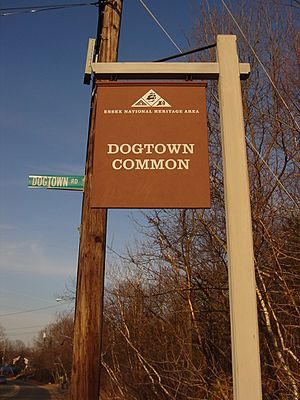Dogtown, Massachusetts facts for kids
Quick facts for kids
Dogtown, Massachusetts
|
|
|---|---|

Dogtown in 1908
|
|
| Country | United States |
| State | Massachusetts |
| County | Essex |
| Settled | 1693 |
| Abandoned | 1830 |
| Time zone | UTC-5 (Eastern) |
| • Summer (DST) | Eastern |
Dogtown is an abandoned village located inland in Gloucester on Cape Ann in Massachusetts. It is also known as Dogtown Commons or Dogtown Common. Today, it is a protected area popular for hiking and exploring.
Contents
What is Dogtown?
Dogtown is a unique place, once a busy village, now a quiet forest. It is split between the city of Gloucester and the town of Rockport. This area was first settled way back in 1693. Legend says its unusual name came from the dogs that women kept for protection. This was especially true when their husbands were away fighting in the American Revolution.
Why People Settled Here
Dogtown was a good place to live because it was inland. This offered protection from pirates and enemy attacks from the sea. At first, the land was used by everyone for wood and grazing animals. But by the early 1700s, people began to build their own homes. At its busiest, Dogtown may have had 60 to 80 houses. Around the mid-1700s, about 100 families lived there. The community was stable until after the American Revolution.
Why Dogtown Became a Ghost Town
After the American Revolution, Dogtown slowly became empty. Several things caused its decline. The fishing industry in Gloucester Harbor became strong again. It was safe for ships to move cargo, leading to more trade. New roads were built along the coast. These roads made it easier to get to Gloucester, which was growing fast.
Moving Away from Dogtown
Many farmers left Dogtown by the end of the War of 1812. They worried about attacks from the coast. Dogtown's reputation also changed. Some of its last residents were thought to be unusual. One woman, Thomazine "Tammy" Younger, was known for intimidating people. Travelers would leave her food to pass safely.
The Last Residents
As the last people moved away or passed on, their pets became wild. This might be another reason for the name "Dogtown." By 1828, almost everyone had left. The very last person living in Dogtown was Cornelius "Black Neil" Finson. He was found in 1830 in a cellar-hole, suffering from frozen feet. He was then taken to a place in Gloucester that cared for people who couldn't support themselves. The last building in Dogtown was torn down in 1845. This marked the end of what was once a busy community.
Dogtown Today: A Natural Wonder
After Dogtown was abandoned, it became an open field with many large rocks. Local farmers used the land to graze their animals. This continued until the 1920s. Over the next few decades, the open land slowly turned into a thick forest.
The Babson Boulders
Today, Dogtown is mostly a dense woodland. It has many trails and old roads. If you walk on Dogtown Road, you can still see the remains of old house foundations. These are called cellar holes. Many are numbered, matching names from a history book about Gloucester.
Roger Babson, whose grandfather wrote that book, did something special during the Great Depression. He hired unemployed stonecutters to carve inspiring messages on 36 large boulders in Dogtown. These are known as the "Babson Boulders." Babson also mapped and numbered the old cellar holes.
Protecting Dogtown's Future
Most of Dogtown is now protected land. It is held in trust by Gloucester and Rockport. This means it will stay wild forever. Dogtown offers great outdoor activities. Hikers, bikers, dog-walkers, and nature lovers enjoy exploring the area. Geologists and historians also find it fascinating.
The area is dotted with huge boulders, some as big as houses. One famous rock was called "The Whale's Jaw." It looked like a whale's mouth before part of it collapsed in 1989. This happened after a campfire got out of control. A section of Dogtown, about 121 acres, is called the Norton Memorial Forest. It is named after Frederick Norton, a scientist who owned land nearby. Starting in the 1930s, Norton planted over 100,000 trees and many types of ferns there. He also created and kept up trails in the area.
-
Babson Boulder near the MBTA tracks indicating the direction of Rockport








